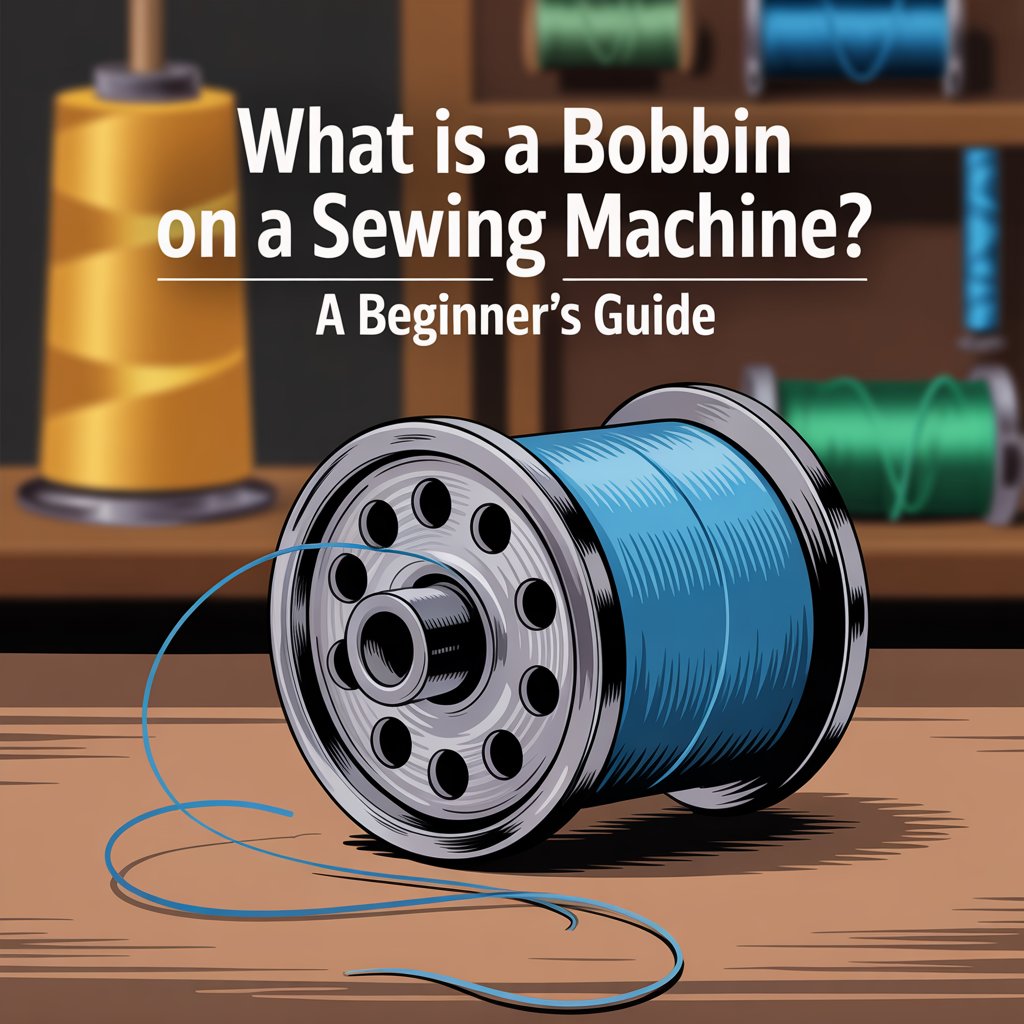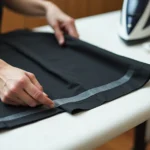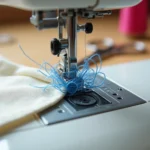A bobbin on a sewing machine is a small spool that holds the lower thread. It works with the needle thread to create stitches by locking both threads together in the fabric. Bobbins are usually made of plastic or metal and fit into a bobbin case or drop-in compartment beneath the needle plate.
What is the Purpose of a Bobbin on a Sewing Machine?
The purpose of a bobbin on a sewing machine extends beyond merely holding thread. This small component forms the foundation of the entire stitching process by providing the lower thread that intertwines with the upper thread to create strong, even seams. Without this crucial interaction between top and bottom threads, machine sewing would be impossible.
Fundamentally, bobbins serve as the source of the bottom portion of stitches. While the top thread comes from the needle, the bottom thread originates from the bobbin. This partnership between upper and lower threads creates what’s known as a lockstitch, the most common and durable stitch type in machine sewing.
During operation, the bobbin rotates in its housing beneath the needle plate, synchronizing precisely with the movement of the needle and feed dogs. As the needle carries the top thread through the fabric, the bobbin hook rotates, catching the top thread and forming a loop around the bobbin case. The bobbin thread is then pulled into this loop, creating an interlocked stitch within the fabric layers. This mechanical choreography repeats with each needle movement, producing a line of secure stitches.

72Pcs 36 Colors Prewound Bobbins and Thread Spools for Hand & Machine Sewing
Check Price
36 Pcs Bobbins and Sewing Threads with Bobbin Case, Assorted Colors Sewing Thread Set
Check PriceTypes of Bobbins and How to Choose the Right One
Selecting the appropriate bobbin is crucial for optimal sewing machine performance. Sewing machines are designed to work with specific bobbin styles, and using the incorrect type can lead to tension problems or machine damage.
Class 15 Bobbins
Class 15 bobbins, also called A Style bobbins, are the most common type used in domestic sewing machines. They measure approximately 20.3 mm in diameter and 11.7 mm in width, roughly the size of an American nickel.These bobbins feature two completely flat sides and are compatible with numerous machine brands including Brother, Singer, Janome, Baby Lock, Bernette, Juki, EverSewn, Pfaff, and many Husqvarna Viking models. Class 15 bobbins typically work with modern drop-in bobbin systems as well as machines with push-in style bobbin cases.
M-Class Bobbins
M-Class bobbins are significantly larger than Class 15 types, approximately the size of an American quarter with a diameter of 24.9 mm and width of 10.7 mm. These bobbins hold nearly twice the amount of thread as smaller bobbins, making them ideal for projects requiring less frequent bobbin changes. M-Class bobbins are commonly used in longarm quilting machines and industrial sewing equipment from manufacturers like APQS, Baby Lock, BERNINA, Brother, Handi Quilter, Innova, and Juki.
Prewound bobbins
Prewound bobbins offer convenience by eliminating the need to wind your own bobbins. Factory-wound using specialized machinery, these bobbins contain 20-40% more thread than self-wound alternatives. Available in various styles (Class 15, L-style, M-style) and materials (cardboard-sided, plastic-sided, sideless, magnetic-core), prewound bobbins come pre-tensioned for consistent stitching. For longarm machines, cardboard-sided prewounds are generally recommended over plastic ones, which can overheat or warp in the bobbin case.
Plastic vs Metal Bobbins
The material composition of bobbins significantly affects performance. Clear plastic bobbins allow easy visibility of remaining thread and typically cost less than metal alternatives. Metal bobbins, usually made of bronze, steel, or aluminum, provide greater durability and work better with thicker threads as their strong sides prevent warping. Importantly, plastic and metal bobbins cannot be interchanged, even if they’re the same size, as machines are calibrated for specific bobbin weights. Generally, machines with metal bobbin cases require metal bobbins, while plastic cases need plastic bobbins.
Drop-in vs Front-loading Bobbins
Sewing machines employ either drop-in (top-loading) or front-loading bobbin systems. Drop-in systems, found in many modern machines, allow the bobbin to be inserted directly into a built-in case beneath the needle plate. Front-loading systems require inserting the bobbin into a separate case before loading it into the machine. Drop-in bobbins offer easier visibility of remaining thread and simpler loading, particularly for beginners. Conversely, front-loading systems allow changing bobbins without removing your project from the machine and often provide superior stitch quality for free-motion quilting and embroidery.

50 Pcs Bobbins, Plastic Bobbins for Sewing Machine, Sewing Bobbins with Bobbin Case
Check Price
Metal Sewing Machine Bobbins, 28 PCS Universal Sewing Machine Bobbins
Check PriceRecommended Bobbins & Accessories for Sewing Machines
Keeping the right bobbins and accessories on hand makes your sewing smoother and more efficient. These top picks ensure your lower thread works perfectly, helping you avoid tangles, skipped stitches, and wasted time.
1. SINGER 21495 Class 15 Threaded Bobbins

SINGER 21495 Class 15 Threaded Bobbins, Transparent, Assorted Colors, 12-Count
Check PriceReliable replacement bobbins compatible with most Singer sewing machines, ideal for keeping multiple thread colors ready for any project.
2. Brother Standard Bobbins (10-Pack)

10-Pack of Style SA-156 Premium Sewing Machine Bobbins Made to Fit Brother Sewing Machines
Check PriceDurable and smooth, designed for Brother machines to prevent thread jams and ensure even stitching.
3. Universal Plastic Sewing Machine Bobbins

50 Pcs Bobbins, Plastic Bobbins for Sewing Machine, Sewing Bobbins with Bobbin Case
Check PriceWork with a variety of sewing machines, perfect for beginners who want extra bobbins ready for multiple projects.
4. Bobbin Thread (Polyester or Cotton)

SINGER Non-Stick Presser Foot | Ideal for Sewing Leather
Check PriceStrong, smooth thread specifically for bobbins, prevents breakage and ensures consistent stitching quality.
5. Bobbin Case & Winder Accessories

72 PCS Sewing Thread Assortment, 36 Color Thread for Sewing Machine with 36 Same Color Bobbins
Check PriceExtra bobbin cases and winders make it easy to pre-wind multiple bobbins and swap them quickly while sewing.
How to Wind and Load a Bobbin
Properly winding and loading a bobbin ensures optimal stitch quality and prevents common sewing issues. This process varies depending on whether you’re using your machine’s built-in winder or a portable device.
Using a built-in bobbin winder
Most sewing machines feature an integrated bobbin winding system that operates through these steps:
- Place your thread spool on the spool pin and secure it with the appropriate spool cap
- Guide the thread through the machine’s thread guides according to your manual’s threading diagram
- Pass the thread through the small hole in your bobbin from inside to outside
- Place the bobbin on the winder pin, making sure it clicks into position
- Push the bobbin winder pin to the right until it locks
- Hold the thread tail while pressing the foot pedal or start button
- Once the bobbin begins winding, release the thread tail
- Allow the bobbin to wind clockwise at full speed for even distribution
The machine will automatically stop when the bobbin is full. Subsequently, cut the thread, push the winder pin back to the left, and remove the bobbin.
Using a portable bobbin winder
Portable winders allow thread winding without unthreading your machine. These devices typically follow this process:
- Extend the spool pin fully and place your thread on it
- Thread through the guide and around the tension disk in a figure-eight pattern
- Insert the thread through the bobbin’s hole from inside to outside
- Place the bobbin on the spindle, ensuring it clicks into place
- Hold the thread tail and press the start button
- Release the thread once it catches and begins winding
- Guide the thread with your finger if necessary for even distribution
Portable winders often feature auto-shutoff mechanisms that stop when the bobbin is full.
Inserting a bobbin into the machine
The loading process differs based on your machine’s bobbin system:
For top-loading (drop-in) machines:
- Remove the transparent bobbin cover plate
- Insert the wound bobbin with thread unwinding counterclockwise
- Guide the thread through the slit in the needle plate
- Replace the bobbin cover
For front-loading machines:
- Hold the bobbin with thread unwinding clockwise
- Insert the bobbin into the case
- Pull the thread through the tension slot
- Place the case into the machine with the metal latch facing upward
- Push until it clicks into place
Common Bobbin Problems and How to Fix Them
Bobbin issues frequently cause sewing machine malfunctions that can disrupt projects. Identifying and resolving these common problems is essential for maintaining stitch quality and extending machine life.
Thread not catching
When the needle fails to pick up bobbin thread, first check that the needle is correctly installed with the flat side facing backward. Moreover, ensure the upper thread is properly threaded through all guides and tension disks. Examine the bobbin case for proper insertion, it should click securely into place. Additionally, inspect the hook assembly for burrs or scratches that may prevent thread pickup. In many cases, a bent or damaged needle will fail to catch the bobbin thread, necessitating replacement.
Loose or uneven stitches
Loose stitches often result from incorrect bobbin tension. To test bobbin tension, hold the thread and let the case hang, it should drop only an inch or two, indicating proper tension. Adjust the small tension screw on the bobbin case: clockwise to tighten, counterclockwise to loosen, making only quarter-turn adjustments.
Consequently, recheck after each adjustment by testing on scrap fabric. Uneven winding can likewise cause inconsistent stitches, hence the importance of rewinding the bobbin with smooth, consistent tension.
Bobbin thread breaking
Bobbin thread breakage typically stems from several factors. First, check for scratches on the bobbin or case that might fray the thread. Inspect the tension spring for proper movement and cleanliness. Furthermore, verify you’re using the correct thread weight, overly thick thread strains the mechanism. Incorrect winding direction can certainly increase thread stress, therefore ensure the bobbin unwinds clockwise when viewed from above.
Wrong bobbin size
Using an incorrect bobbin size creates numerous problems including tension issues, thread jamming, and needle breakage. Indeed, even if a bobbin physically fits, it may still be wrong for your machine, potentially throwing off timing and breaking needles. Always consult your machine’s manual to identify the proper bobbin class and material.
Lint buildup in bobbin case
Regular cleaning prevents performance issues caused by lint accumulation. Remove the bobbin case and plate, thereafter use a small brush to gently clean away lint and thread fragments. Clean under the tension spring using a business card or thin cardboard to push out debris. Never use canned air, which pushes lint deeper into the machine. For thorough cleaning, consider removing the cover plate to access all areas beneath the bobbin case.
Frequently Asked Questions About Bobbins
Q1: What size bobbin do I need for my sewing machine?
Check your sewing machine manual, most machines have specific bobbin sizes, like Class 15 for Singer or standard Brother bobbins. Using the wrong size can cause thread jams.
Q2: How do I wind a bobbin?
Place the thread on the spool pin, thread it through the bobbin winder, and start your machine. Stop when the bobbin is full, then cut the thread and insert it into the bobbin case.
Q3: Can I use any bobbin in any machine?
No, always use bobbins designed for your machine brand and model. Universal bobbins may work for some machines but can cause tension or stitching issues.
Q4: How do I prevent thread tangles from the bobbin?
Make sure the bobbin is wound evenly and inserted correctly in the bobbin case. Use good-quality thread and adjust tension as needed.
Q5: How often should I replace bobbins?
Bobbins rarely wear out, but if they’re scratched, warped, or consistently cause tension issues, it’s time to replace them.
Conclusion
Understanding what a bobbin is on a sewing machine is essential for every sewist, whether you’re a beginner or a seasoned pro. The bobbin holds the lower thread and works with the needle thread to create clean, even stitches. Choosing the right bobbin, winding it correctly, and using quality thread can prevent common sewing issues like tangles, skipped stitches, or uneven seams.
By keeping extra bobbins, thread, and essential accessories on hand, you’ll save time, reduce frustration, and ensure every project turns out perfectly. Mastering your bobbin is a small step that makes a big difference in achieving professional-looking results in all your sewing projects.


